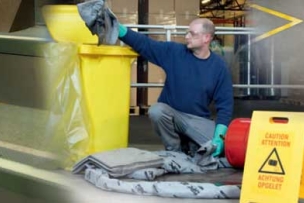Q: What does it take to inspire a culture of safety at work?
You can’t leave this to the individual. You almost need accountability partners, because this is a team effort. Everybody works together. Everybody checks each other. And everybody knows their work mates well enough so that if someone is being lax and not really engaged, they can call them on it.
If you’re running a press or a drill, or something that could stab or burn you, or cut you in half, if you’re not engaged in your work there’s a potential for an injury or death, so you can’t become complacent.
Whenever people ask me about safety culture, I tell them you have to be accountable to each other. All of you should look out for each other if you’re on a shift, if you’re on a crew or on a team. You don't let your guard down and think well, you know, I don’t need to worry about it today, because that could be the day you get seriously injured.
Sometimes you might want to just back up and act like today's your first day at work. And I know that is not the thing that a line production manager wants to hear, because they’ve got to have so much production done in a day, and workers are going to work slower, but stepping back and thinking for a second can save your life.
Q: The COVID-19 pandemic has heightened concerns about workplace safety. What are your recommendations for handling it?
People are sheltering in place, their kids are at home, and nothing is familiar or normal anymore. You may be wondering about your job, about paying the bills, about protecting your family from getting sick. You’ve got a million questions running through your head at one time. It’s a major distraction.
To get past all that is hard to do, but at work safety has to come first. Otherwise, every time you drive to work or start a shift, you’re going to be thinking about it and you won’t be focused on the task at hand; you won’t be fully engaged. Every bit of it has to stay outside of the job, and that’s very hard to do.
I recommend thinking about what’s important: your family and your safety. Tell yourself if you want to get back home to them safely every day, you need to follow all the safety rules. Don’t lose your focus on the job at hand. And if you do, if your mind wanders for a second, back up, back away from what you’re doing for a moment and just do whatever you have to do to get your head back into it.
You just need to take it a day at a time, and you’ve got to find the positive in each day. Remember each morning to be grateful for being alive, for having a roof over your head. Go through a checklist of positives in your head instead of, “Oh my gosh, the virus can get me, what am I going to do, how am I going to make money?” We are human, so we worry, but we also have the ability to try to reason through things.
After my accident I decided I wasn’t going to be controlled by what happened to me. I was not going to spend my life being supported by the government. I was going to go back to work. I was going to be a functioning part of society. I was going to do whatever it took. That journey has led to where I am today speaking to thousands of people across the United States and I never envisioned that. I had no idea any of that would happen when I was lying in that hospital bed.
Q: How do you see workplace safety developing in the future?
We need to celebrate safety at work with positive reinforcement. When employees feel their efforts to keep others safe are recognized, a positive safety culture can grow.
Every day we make progress toward that goal. I’ve told people a thousand times how I wish no one ever had to ask me to do another presentation because we have reached that point, but until then we’re going to keep working at it. We’re going to keep innovating, and we’re going to keep doing the things we need to do to build safer workplaces.
To learn more about Lee Shelby visit leeshelby.com.






Talk to Us!
Nice interview.
Keep it all together safe there!
28Leave a reply
Your email address will not be published. Required fields are marked *